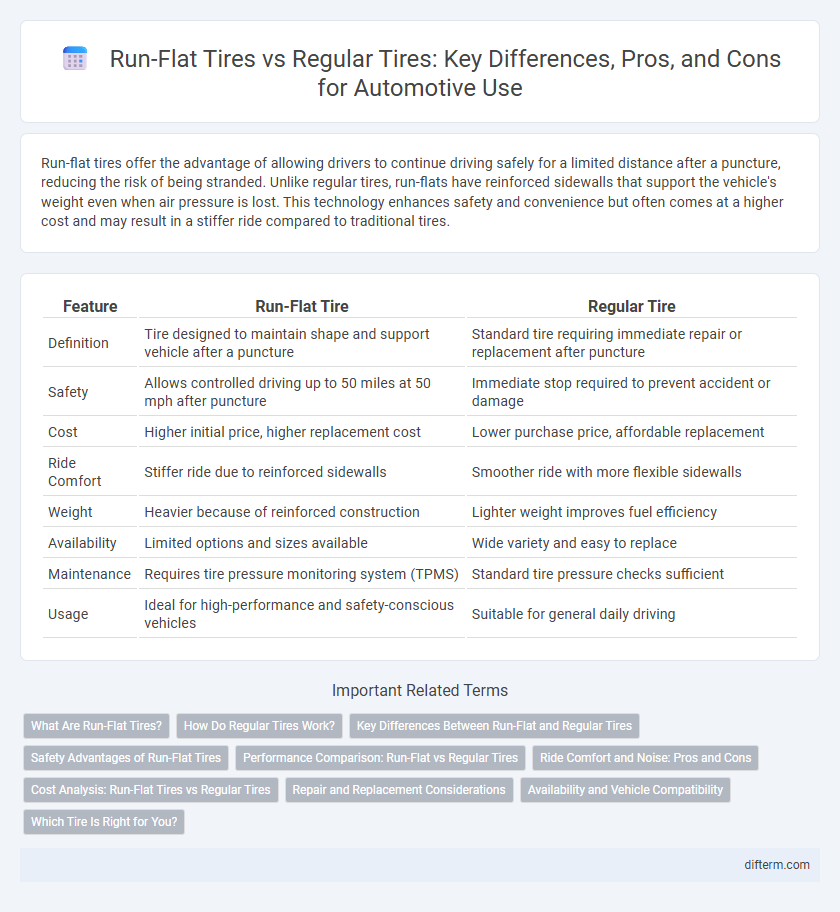Run-flat tires offer the advantage of allowing drivers to continue driving safely for a limited distance after a puncture, reducing the risk of being stranded. Unlike regular tires, run-flats have reinforced sidewalls that support the vehicle's weight even when air pressure is lost. This technology enhances safety and convenience but often comes at a higher cost and may result in a stiffer ride compared to traditional tires.
Table of Comparison
| Feature | Run-Flat Tire | Regular Tire |
|---|---|---|
| Definition | Tire designed to maintain shape and support vehicle after a puncture | Standard tire requiring immediate repair or replacement after puncture |
| Safety | Allows controlled driving up to 50 miles at 50 mph after puncture | Immediate stop required to prevent accident or damage |
| Cost | Higher initial price, higher replacement cost | Lower purchase price, affordable replacement |
| Ride Comfort | Stiffer ride due to reinforced sidewalls | Smoother ride with more flexible sidewalls |
| Weight | Heavier because of reinforced construction | Lighter weight improves fuel efficiency |
| Availability | Limited options and sizes available | Wide variety and easy to replace |
| Maintenance | Requires tire pressure monitoring system (TPMS) | Standard tire pressure checks sufficient |
| Usage | Ideal for high-performance and safety-conscious vehicles | Suitable for general daily driving |
What Are Run-Flat Tires?
Run-flat tires are designed with reinforced sidewalls that allow vehicles to continue driving safely for up to 50 miles at reduced speeds after a puncture or loss of air pressure. Unlike regular tires, they eliminate the immediate need for roadside tire changes, enhancing safety and convenience. These tires are commonly integrated with Tire Pressure Monitoring Systems (TPMS) to alert drivers of pressure loss.
How Do Regular Tires Work?
Regular tires rely on pressurized air to maintain their shape and provide cushioning between the vehicle and the road, ensuring optimal traction and handling. They require constant air pressure monitoring and maintenance to prevent blowouts and maintain fuel efficiency. Unlike run-flat tires, regular tires lose functionality immediately after a puncture, necessitating a prompt tire change or repair.
Key Differences Between Run-Flat and Regular Tires
Run-flat tires feature reinforced sidewalls that support the vehicle's weight even when air pressure is lost, allowing continued driving for up to 50 miles at reduced speeds. Regular tires rely on maintaining proper air pressure and typically become unusable immediately after a puncture, requiring prompt replacement or repair. Run-flat technology enhances safety and convenience by minimizing downtime, whereas regular tires often offer a smoother ride and lower cost but lack emergency mobility capabilities.
Safety Advantages of Run-Flat Tires
Run-flat tires enhance safety by allowing drivers to continue driving for up to 50 miles at reduced speeds after a puncture, reducing the risk of sudden loss of control and enabling safer access to repair services. Their reinforced sidewalls prevent rapid deflation, which is common in regular tires, minimizing the chance of accidents caused by blowouts. The stability maintained by run-flat tires during a puncture improves vehicle handling and reduces roadside emergency situations, significantly benefiting overall driving safety.
Performance Comparison: Run-Flat vs Regular Tires
Run-flat tires maintain vehicle mobility up to 50 miles at 50 mph after a puncture, providing superior safety and convenience compared to regular tires that require immediate repair. Run-flats typically have stiffer sidewalls, resulting in firmer handling and reduced risk of blowouts but can produce a harsher ride and increased road noise. Regular tires often offer better fuel efficiency and ride comfort due to their flexible sidewalls but lack the emergency mobility features inherent to run-flat designs.
Ride Comfort and Noise: Pros and Cons
Run-flat tires provide enhanced safety by allowing continued driving after a puncture but often result in a stiffer ride and increased road noise due to reinforced sidewalls. Regular tires typically offer superior ride comfort and lower noise levels, benefiting from more flexible sidewalls that absorb road vibrations better. Choosing between the two depends on the priority given to safety features versus driving comfort and noise reduction.
Cost Analysis: Run-Flat Tires vs Regular Tires
Run-flat tires typically cost 20% to 50% more upfront compared to regular tires due to reinforced sidewalls and advanced materials. Maintenance costs can also be higher since run-flat tires often require replacement instead of repair after a puncture, influencing long-term expenses. However, eliminating the need for roadside tire changes can offset some costs through enhanced convenience and reduced towing fees.
Repair and Replacement Considerations
Run-flat tires often require specific repair procedures and specialized equipment, limiting repair options compared to regular tires that can be more easily patched or plugged. Replacement costs for run-flat tires tend to be higher due to advanced sidewall technology and limited availability. Vehicle owners should also consider that run-flat tires typically must be replaced as a full set to maintain balanced performance and safety.
Availability and Vehicle Compatibility
Run-flat tires have gained widespread availability in recent years, with major manufacturers offering them as original equipment on various vehicle models, particularly luxury and performance cars. Compatibility with vehicles requires specific suspension tuning and tire pressure monitoring systems (TPMS) to ensure safe operation, limiting their use mostly to newer cars designed or adapted for run-flat technology. Regular tires remain universally compatible with almost all vehicles and are more readily available across a broader range of tire shops and markets worldwide.
Which Tire Is Right for You?
Run-flat tires provide enhanced safety by allowing you to drive up to 50 miles at reduced speeds after a puncture, minimizing the risk of being stranded. Regular tires generally offer better ride comfort, lower rolling resistance, and are more cost-effective to replace or repair. Choosing between run-flat and regular tires depends on your driving habits, vehicle compatibility, and prioritization of safety versus comfort and cost.
run-flat tire vs regular tire Infographic

 difterm.com
difterm.com